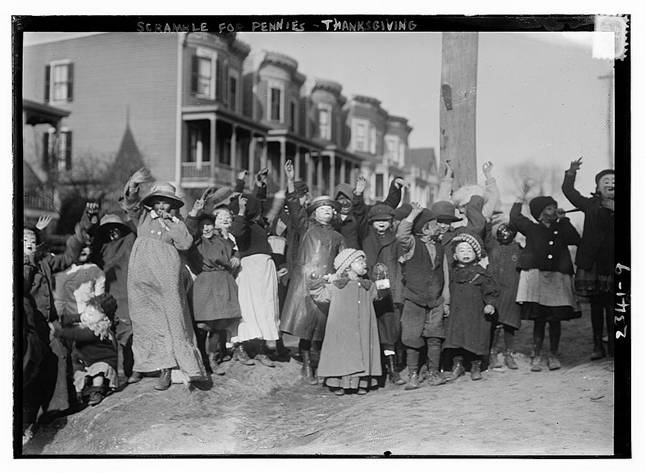From a Boys' Perspective
Boys, especially older ones, got to venture "beyond the fences" with some frequency. Perhaps the most common reason was so that they could march in the village's regular parades. During the Great War, the Liberty Bond drives involved parades, social activities, and displays of military vehicles and weapons, all of which most boys would have found interesting. The 1919 Independence Day parade and homecoming celebrations for those who served in uniform would have been exceptionally memorable.
Although the number of boys at the Protectory was small, it was able to field sports teams that competed against teams from other organizations or schools. Its choir and chorus often performed at public events, as did its band. A high note (yes, that's a pun) occurred in 1934, when the Protectory Band was invited to play in the parade that celebrated Brooklyn's Tercentenary.
*
Perhaps the best outing a boy might have all year happened on Thanksgiving Day - and not for the reasons you might guess.
If we could look back a century or more, to some past Thanksgiving, and see the streets of some American town or city, we might think that we were witnessing a Hallowe'en. Costumed children (then called "ragamuffins") would be running through the streets, stopping passers-by and ringing doorbells, holding out their hands, and saying "Anything for Thanksgiving?" With luck, they'd get a candy or cookie in response. With better luck, they'd get a penny or two.

Looking like a nightmare directed by Federico Fellini, ragamuffins in
an unidentified early twentieth century American town compete for
attention, hoping that some pennies will be thrown their way.
Bain News Service, Publisher.
Scramble for pennies - Thanksgiving. [Between and Ca. 1915] Photograph.
Retrieved from the Library of Congress, www.loc.gov/item/2014689991/
It all goes back to the story which Americans associate with the first Thanksgiving. Had it not been for the good will and generosity of strangers - the native Americans - the Pilgrims would not have survived their first winter in America. Thanksgiving is a way of celebrating and re-creating that selfless kindness.
Somewhere along the line, however, by the nineteenth century, American popular culture had tapped into the legends of the Elizabethan era, when bands of beggars, singing rowdily and playing music, would arrive at a town one day and half-intimidate the locals into giving them alms (which they often did, just to get the beggars to leave town as soon as possible). Ragamuffins originally were children dressed to look like beggars, wearing ill-fitting worn old clothes, and deliberately smudged with coal dust to look dirty (the homemade masks and more fanciful costumes came later). They'd start Thanksgiving Day by assembling in some designated spot, and then "march" in what was called the Ragamuffin Guards or the Ragamuffin Parade. Serenading the public was optional.
On the day after an especially good Thanksgiving for the Protectory boys, newspaper readers saw the following:

Wow, that means that there were more than
enough celery stalks to go around. Yippee!
Excerpts from the Huntington Long-Islander, November 27, 1914
*
Obviously, Christmas at the Protectory was always a high point. The newspaper report of the 1903 holiday informs us that the arrangements had been made by Sister Superior Adelaide and her five assistants. The day began in the Chapel at 7:00 AM, when Father Fuchs celebrated Mass, at which the boys' choir sang, with the professional choir master singing solos. The meal began at 11:30 AM, and after a suitable interval, the boys' gifts ("useful articles, books, candies, nuts, and fruit") were distributed. Christmas trees stood in two public spaces, each tree bedecked with ornaments made by the boys.
Prior to Christmas, the boys had been visited by H.B. Fullerton,* who had spoken to them about new scientific advances in agriculture.
* Fullerton was in charge of the LIRR's Demonstration Farm, created to expose Long Islanders to improved farming methods. He also worked personally with President Roosevelt to find ways of improving the nation's food supply.
*
June of every year meant a graduation ceremony. With fewer than 125 boys of school age, the graduating class size was small, and the ceremony would have been very personal and emotional for all. Speeches were made, the chorus sang, prayers were offered, and the graduates received academic, athletic, and other awards, as well as their diplomas.
At some point, the Protectory introduced the idea of allocating to each older boy a personal garden plot, 20' x 20' in size. This allowed the boys to compete with each other, and thereafter, gardening prizes for their plots also were awarded to boys upon graduation.
***

